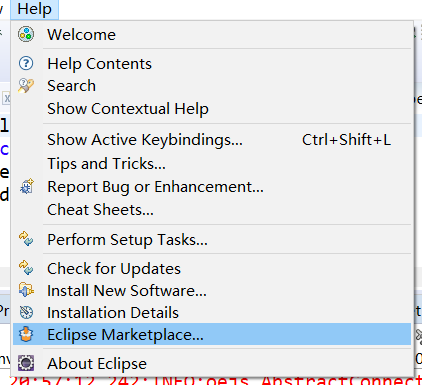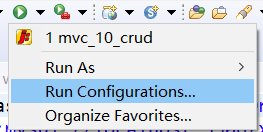find输入jetty进行安装
安装给你完重启
1.文末先创建d:/jetty.xml
配置jetty服务器
argument配置jeety.xml的路径
启动浏览器输入localhost:8080就能访问了
创建d:/jetty.xml
<?xml version="1.0"?>
<!DOCTYPE Configure PUBLIC "-//Jetty//Configure//EN" "http://www.eclipse.org/jetty/configure_9_0.dtd">
<!-- =============================================================== -->
<!-- Documentation of this file format can be found at: -->
<!-- http://wiki.eclipse.org/Jetty/Reference/jetty.xml_syntax -->
<!-- -->
<!-- Additional configuration files are available in $JETTY_HOME/etc -->
<!-- and can be mixed in. See start.ini file for the default -->
<!-- configuration files. -->
<!-- -->
<!-- For a description of the configuration mechanism, see the -->
<!-- output of: -->
<!-- java -jar start.jar -? -->
<!-- =============================================================== -->
<!-- =============================================================== -->
<!-- Configure a Jetty Server instance with an ID "Server" -->
<!-- Other configuration files may also configure the "Server" -->
<!-- ID, in which case they are adding configuration to the same -->
<!-- instance. If other configuration have a different ID, they -->
<!-- will create and configure another instance of Jetty. -->
<!-- Consult the javadoc of o.e.j.server.Server for all -->
<!-- configuration that may be set here. -->
<!-- =============================================================== -->
<Configure id="Server" class="org.eclipse.jetty.server.Server">
<!-- =========================================================== -->
<!-- Configure the Server Thread Pool. -->
<!-- The server holds a common thread pool which is used by -->
<!-- default as the executor used by all connectors and servlet -->
<!-- dispatches. -->
<!-- -->
<!-- Configuring a fixed thread pool is vital to controlling the -->
<!-- maximal memory footprint of the server and is a key tuning -->
<!-- parameter for tuning. In an application that rarely blocks -->
<!-- then maximal threads may be close to the number of 5*CPUs. -->
<!-- In an application that frequently blocks, then maximal -->
<!-- threads should be set as high as possible given the memory -->
<!-- available. -->
<!-- -->
<!-- Consult the javadoc of o.e.j.util.thread.QueuedThreadPool -->
<!-- for all configuration that may be set here. -->
<!-- =========================================================== -->
<Arg name="threadpool">
<New id="threadpool" class="org.eclipse.jetty.util.thread.QueuedThreadPool">
<Arg name="minThreads" type="int">10</Arg>
<Arg name="maxThreads" type="int">200</Arg>
<Arg name="idleTimeout" type="int">60000</Arg>
<Set name="detailedDump">false</Set>
</New>
</Arg>
<!-- =========================================================== -->
<!-- Add shared Scheduler instance -->
<!-- =========================================================== -->
<Call name="addBean">
<Arg>
<New class="org.eclipse.jetty.util.thread.ScheduledExecutorScheduler"/>
</Arg>
</Call>
<!-- =========================================================== -->
<!-- Http Configuration. -->
<!-- This is a common configuration instance used by all -->
<!-- connectors that can carry HTTP semantics (HTTP, HTTPS, SPDY)-->
<!-- It configures the non wire protocol aspects of the HTTP -->
<!-- semantic. -->
<!-- -->
<!-- This configuration is only defined here and is used by -->
<!-- reference from the jetty-http.xml, jetty-https.xml and -->
<!-- jetty-spdy.xml configuration files which instantiate the -->
<!-- connectors. -->
<!-- -->
<!-- Consult the javadoc of o.e.j.server.HttpConfiguration -->
<!-- for all configuration that may be set here. -->
<!-- =========================================================== -->
<New id="httpConfig" class="org.eclipse.jetty.server.HttpConfiguration">
<Set name="secureScheme">https</Set>
<Set name="securePort"><Property name="jetty.secure.port" default="8443" /></Set>
<Set name="outputBufferSize">32768</Set>
<Set name="requestHeaderSize">8192</Set>
<Set name="responseHeaderSize">8192</Set>
<Set name="sendServerVersion">true</Set>
<Set name="sendDateHeader">false</Set>
<Set name="headerCacheSize">512</Set>
<!-- Uncomment to enable handling of X-Forwarded- style headers
<Call name="addCustomizer">
<Arg><New class="org.eclipse.jetty.server.ForwardedRequestCustomizer"/></Arg>
</Call>
-->
</New>
<Call name="addConnector">
<Arg>
<New class="org.eclipse.jetty.server.ServerConnector">
<Arg name="server"><Ref refid="Server" /></Arg>
<Arg name="factories">
<Array type="org.eclipse.jetty.server.ConnectionFactory">
<Item>
<New class="org.eclipse.jetty.server.HttpConnectionFactory">
<Arg name="config"><Ref refid="httpConfig" /></Arg>
</New>
</Item>
</Array>
</Arg>
<Set name="host"><Property name="jetty.host" /></Set>
<!-- 配置端口 -->
<Set name="port"><Property name="jetty.port" default="8080" /></Set>
<Set name="idleTimeout">30000</Set>
</New>
</Arg>
</Call>
<!-- =========================================================== -->
<!-- Set the default handler structure for the Server -->
<!-- A handler collection is used to pass received requests to -->
<!-- both the ContextHandlerCollection, which selects the next -->
<!-- handler by context path and virtual host, and the -->
<!-- DefaultHandler, which handles any requests not handled by -->
<!-- the context handlers. -->
<!-- Other handlers may be added to the "Handlers" collection, -->
<!-- for example the jetty-requestlog.xml file adds the -->
<!-- RequestLogHandler after the default handler -->
<!-- =========================================================== -->
<Set name="handler">
<New id="Handlers" class="org.eclipse.jetty.server.handler.HandlerCollection">
<Set name="handlers">
<Array type="org.eclipse.jetty.server.Handler">
<Item>
<New id="Contexts" class="org.eclipse.jetty.server.handler.ContextHandlerCollection"/>
</Item>
<Item>
<New id="DefaultHandler" class="org.eclipse.jetty.server.handler.DefaultHandler"/>
</Item>
</Array>
</Set>
</New>
</Set>
<!-- =========================================================== -->
<!-- extra server options -->
<!-- =========================================================== -->
<Set name="stopAtShutdown">true</Set>
<Set name="stopTimeout">5000</Set>
<Set name="dumpAfterStart">false</Set>
<Set name="dumpBeforeStop">false</Set>
</Configure>



